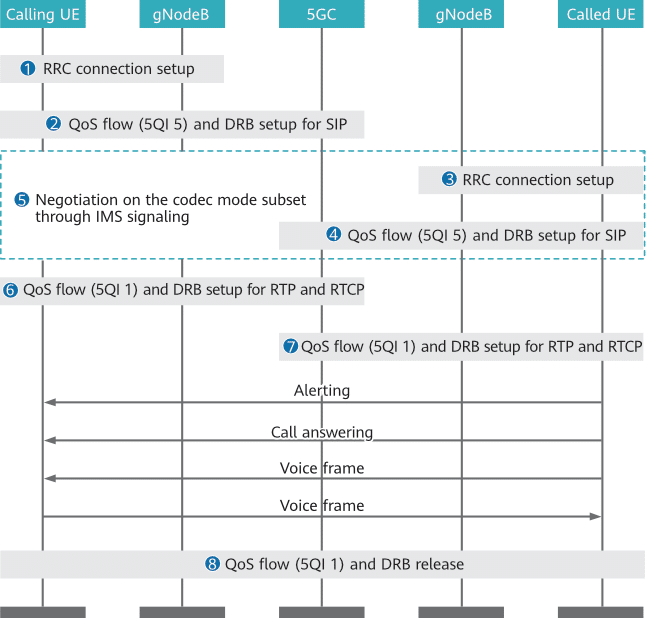With VoNR, IP-based dedicated voice bearers are set up between UEs and the IMS on the NR network, enabling NR UEs to directly perform voice services on the NR network. A VoNR call can be a normal call or an emergency call based on different UE applications. Normal call and emergency calls have different procedures for setting up and releasing a voice bearer between two UEs.

The detailed process is as follows:
- When a UE initiates a call, an RRC connection is set up between the calling UE and its serving gNodeB.
- The 5G core network (5GC) sets up a quality of service (QoS) flow with a 5G QoS Identifier (5QI) of 5 for the calling UE to carry Session Initiation Protocol (SIP) signaling, and the gNodeB sets up the corresponding data radio bearer (DRB).
- An RRC connection is set up between the UE that receives the call and its serving gNodeB.
- The 5GC sets up a QoS flow with a 5QI of 5 for the called UE to carry SIP signaling, and the gNodeB sets up the corresponding DRB.
- The calling and called UEs and the IMS perform SIP negotiation on the codec scheme, IP address, port number, information of both calling and called UEs, and other voice service information.
- After SIP negotiation is successful, the 5GC sets up a QoS flow with a 5QI of 1 for the calling UE to carry Real-Time Transport Protocol (RTP) and Real-Time Transport Control Protocol (RTCP) data flows, and the gNodeB sets up the corresponding DRB.
- The 5GC sets up a QoS flow with a 5QI of 1 for the called UE to carry RTP and RTCP data flows, and the gNodeB sets up the corresponding DRB.
- After the call ends, the calling and called UEs release their QoS flows with a 5QI of 1, and the gNodeBs release the corresponding DRBs. The default bearers with a 5QI of 5 are released only when the UEs enter the idle state.
Don’t miss our Voice over NR Training course to learn more about this technolgy.
Benefit from Massive discount on our 5G Training with 5WorldPro.com
Start your 5G journey and obtain 5G certification
contact us: contact@5GWorldPro.com


